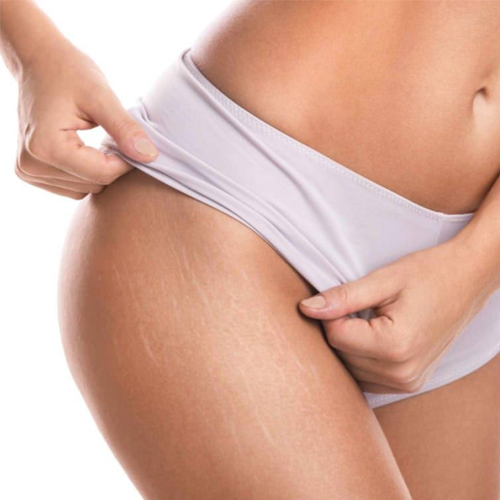Stretch Mark Reduction

What are Stretch Marks
Stretch marks, or striae, are a form of skin scarring associated with pregnancy, obesity, puberty, and short-term weight gain from bodybuilding and other physical activities. They form when the dermis – the middle layer of the skin that maintains shape and elasticity – is stretched more than it can tolerate. Connective fibers in the skin eventually break, disrupting collagen production and causing scarring.
Causes of Stretch Marks
Both men and women are susceptible to stretch marks, particularly on the thighs, hips, arms, buttocks, abdominal area, and lower back. There are several causes of stretch marks, including:
Genetics: Women are more likely to get belly stretch marks if their mother, for instance, had stretch marks after pregnancy. Significant weight gain and loss: Your skin stretches as your weight fluctuates, sometimes resulting in stretch marks.
Puberty: Growth spurts during puberty often result in stretch marks as the skin is unable to keep up with the body's rate of growth.
Bodybuilding: Rapid development of muscle mass may stretch the skin beyond its limits.
Corticosteroids: Heavy or long-term use of oral or topical corticosteroids, a widely used pharmaceutical steroid compound, can lead to stretch mark formation.
Ethnicity: People with darker skin are less likely to have stretch marks.
Pregnancy: Stretch marks after pregnancy are particularly common. Nearly three in four women will develop stretch marks on their legs, abdomen, hips, and other areas of the body affected by weight gain during pregnancy.
During pregnancy, the skin expands and stretches to its limit, causing tiny tears in the supporting layers of skin. These tiny tears are stretch marks that appear as glossy, white streaks in the skin.
Areas of the Body That Can Be Affected by Stretch Marks
Stretch marks can affect any area of the body in which the skin is subject to rapid stretching. The abdomen is the area most often affected by stretch marks, but they are also common around the thighs, hips, buttocks, lower back, arms, and chest.
Treatments:
Natural Stretch Mark Removal
Traditional stretch mark removal treatments include creams, lotions, and recommendations for regular diet and exercise. There are a wide variety of products available on the market for natural stretch mark removal.
Laser Stretch Mark Removal
During a laser stretch mark removal procedure, a beam of light removes thin layers of skin around the stretch marks. The excimer laser is uniquely effective for this procedure. Instead of burning or cutting the affected skin areas like other lasers, it uses high-energy ultraviolet laser light to disrupt the molecular bonds in the skin tissue, which causes the tissue to disintegrate in a process known as ablation. Once laser stretch mark removal is complete, the treated area will heal quickly, and new layers of healthy skin will form. Stretch marks will have disappeared, and a renewed, healthy appearance will result. More Details
Microdermabrasion
Microdermabrasion improves the appearance of stretch marks through the removal of the skin’s top layers. Microdermabrasion uses a fine crystal spray to “blast” the outermost layers of skin. Dead skin cells are removed and new, healthy skin cells take their place. The new cells produce more collagen and elastin, two vital components of smooth, young looking skin. Microdermabrasion is a painless procedure that takes no more than an hour to complete and involves little recovery time. Few sessions are needed to reap the maximum benefits of the procedure.